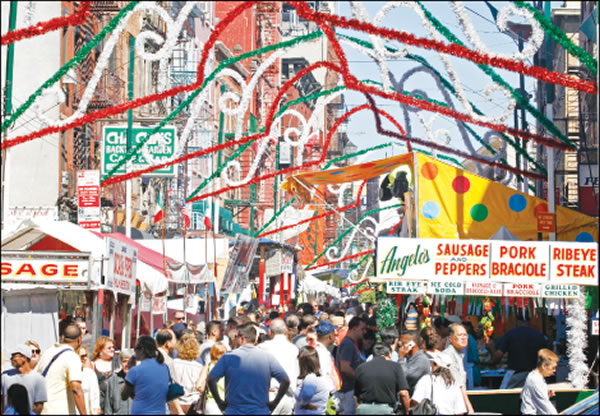By Victor J. Papa
San Gennaro’s lore as a martyred saint under Emperor Diocletian, indeed Gennaro’s life and his miracles, have imbued the soul of Naples and her people for centuries. This is the same Neapolitan soul that was borne by a poor and noble immigrant people over the Atlantic Ocean all the way to Mulberry St. during the great immigration phase of 19th-century American history. Thus, the San Gennaro Feast, firmly established in his name and consistently celebrated since 1926, is a public manifestation of an Italian immigrant group’s reverence for celebrating their saint’s day on Sept. 19.
So how come Community Board 2 doesn’t necessarily see it that way? Why have some local residents lost tolerance for it? Why do some of the merchants along Mulberry St. agonize over its duration? Some say it’s a question of authenticity — a feast afflicted with serious deficiencies as hard to defend as they are easy to exploit by anyone who, for whatever reason, chooses to take issue with it.
I derive a right to say these things. I am a Catholic, an Italian-American and a New Yorker. I live and work in Downtown Manhattan. And I work every day in the interests of the Little Italy merchants and tenants toward furthering tenant rights, economic recovery and the historic preservation of what is now a neighborhood quite near extinction, in spite of the fact that it is a major tourist and visitor destination. It is a historic neighborhood important to understanding the Italian immigrant experience in American social history. Intrinsic to its unique ethnic identity is the San Gennaro Feast — a boon to New York City and an icon to Italian-Americans all over the nation. But the fate of this very vulnerable neighborhood must not be forsaken and left to the risks of an annual event increasingly bereft of the imagination, reverence and soul upon which it was founded.
The feast’s sponsors need to come to terms with this fact — and also acknowledge that criticisms about the feast are sentiments shared by many Italian-Americans. And because they come from within the Italian-American community, these critiques might hold more validity than anyone else’s. And because they come from within that community, they cannot easily be summarized as bigotry or as anti-Catholic. For how can anyone who takes issue with the feast be characterized as “anti-Catholic” or as “anti-Italian” if there is hardly anything about the feast that is Catholic or Italian to offend? The feast sponsors are responsible for protecting Catholic identity and Italian heritage, as the nature of the event implies. They can only assume that role by being more authentically Catholic and more authentically Italian in their obligation to restore to the feast the best that those two traditions have to offer. That means restoring the feast to its rightful religious and ethnic authenticity — or, I fear, there goes the feast, along with its symbiotic partner, Little Italy.
Also important is the idea that the feast is not the exclusive domain of anyone: not the sponsors, not the community board, not the residents or merchants of Little Italy, and not the city of New York. The feast is also to be reclaimed by Italian-Americans at large. They, too, are major stakeholders and have a rightful voice to re-imagine the feast, insisting that it become an educational and cultural enterprise of a civilization worthy of imparting on Mulberry St. (sorry, Diocletian) Dante’s poetry, Rossini’s never-ending overtures, or the wonders of Michelangelo’s incomparable, sculptured marble — a bold display of a heritage that goes beyond offensive caricatures. What an opportune time, as well, to mark in a moment of solemnity the tragedy of 9/11, and the centennial of the Italian Republic, or to consider the feast as an opportunity to invite the city of Naples — and its archbishop, Cardinal Sepe — to participate.
And yes, the feast should be extended all the way to Houston St. But certainly not at the cost of the debacle that merchants and residents there had to endure last year. If the novelty of caged animals and unregulated A.T.M. machines was the creative answer to filling the gap between Kenmare and Houston Sts., then what could be said of the sponsors affronting the ennobled basilica of St. Patrick’s Old Cathedral, and the nearby residents and merchants, with such a display?
The need for a dialogue within the community is all too obvious and urgent and it should be initiated by the feast sponsors now. It must be a dialogue that engages elected officials, community board members and the basilica, and that includes the residents and merchants of Little Italy and Nolita and, not least, Italian-American organizations. It should be an open and welcoming dialogue, creative and resolute toward resolving the hard questions about the feast itself, with a clear focus and vision to restoring its relevancy and its authenticity to a level worthy of San Gennaro’s enduring patronage of Naples and Little Italy.



























